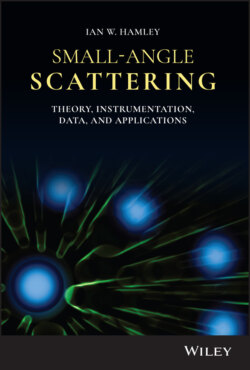Читать книгу Small-Angle Scattering - Ian W. Hamley - Страница 28
1.7.4 Effect of Polydispersity
ОглавлениеParticle polydispersity has a considerable influence on the shape of the form factor. It is included via integration over a particle size distribution D(R′):
(1.100)
Here the subscript 0 has been added to the form factor, in order to emphasize that this is the term for the monodisperse system.
The effect of polydispersity for the example of the form factor of a uniform sphere of radius R is illustrated in Figure 1.19. The polydispersity in this case is represented by a Gaussian function:
(1.101)
Figure 1.19 Influence of polydispersity on the form factor of a sphere with R = 30 Å in terms of a Gaussian standard deviation with width σ (in Å) indicated.
Here σ is the standard deviation, which is related to the full width at half maximum by , and c is a normalization constant. Other forms of distribution can be used and may be motivated by known dispersity distributions (based on the system synthesis, for example), for example log‐normal functions, Schulz‐Zimm functions etc.
It is clear from the example of calculated form factors for a uniform sphere in Figure 1.19 that increasing σ causes the form factor oscillations to get progressively washed out such that they are largely eliminated for σ = 7.5 Å (25% of the radius R).
It can be difficult in some cases (in particular, when measurements extend over only a small q range and/or for highly polydisperse systems) to disentangle polydispersity from the effect of particle anisotropy, which can also smear out form factor minima. This is illustrated by the example of Figure 1.20 which compares the calculated form factor for a sphere (R = 30 Å, σ = 1.5) with that of a monodisperse ellipsoid with R1 = 29 Å and R2 = 34.8 Å. The form factors are quite similar at low q (and this example has not been optimized for maximal similarity). Especially with lower resolution SANS experiments (see Section 5.5.1 for a discussion of the resolution function for SANS), the two profiles in Figure 1.20 are not distinguishable at low q.
Figure 1.20 Comparison of form factor of a polydisperse sphere (R = 30 Å, σ = 1.5) and a monodisperse ellipsoid with R1 = 29 Å and R2 = 34.8 Å.
